written and photographed by Mary L. Peachin
Vol. 24, No. 5, February 2021
(Note from Mary: Since Covid has grounded me, I am running some favorite past articles. This can also be found in Sleeping Around…Challenging My Comfort Zone now available on Amazon and Barnes and Noble. )
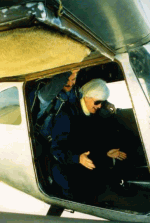 The sign on the door of the pickup truck said, “The Bad Spot Cab Company-You Fall, We Haul, That’s All, You All!” It’s probably better that I didn’t notice the sign as I climbed out of the cab and into the single-prop Cessna 182, on my way to 11,000 feet.
The sign on the door of the pickup truck said, “The Bad Spot Cab Company-You Fall, We Haul, That’s All, You All!” It’s probably better that I didn’t notice the sign as I climbed out of the cab and into the single-prop Cessna 182, on my way to 11,000 feet.
The day was crisp and clear, visibility unlimited, with the winds light and variable, the kind of day we pilots consider a beautiful flying day. But on this day, of course, instead of flying the plane I would be climbing onto the wing strut and plunging through the wild blue yonder. My friend Pat Gordon and I had arrived at the Avra Valley airfield near Tucson, Arizona, then quickly signed away all of our rights to Marana Skydiving, after being advised about the life-threatening risks of falling 11,000 feet.
We were there to try tandem diving, in which novice divers fall to earth attached to the chute of an instructor, without having to take a course. We started on the tarmac. Dressed in a flight suit complete with leather Amelia Earhart-type cap, Greg Behrens, instructor and owner of Marana Skydiving, showed us how to exit the single-engine Cessna. Pat and I took turns kneeling on the airplane floor with Greg behind us; Greg’s chute would be buckled to our harness.
Exiting requires reaching outside the airplane, holding the strut, right foot next to the wheel and left foot on the side step of the door. I assumed the position, and Greg placed his feet next to mine. When he said “Ready,” I lifted my head and feet as if I were jumping out of the plane; he was holding my entire weight below him in a parallel position.
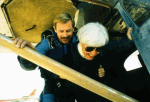 Hanging there inches from the ground, I had a sudden realization: the instructor is not the “cushion” in a tandem dive; he does not break your fall. No- I would be the first to hit the ground. I shook off the image as Greg taught me to keep my feet together and fall backwards onto my rear. A few more preliminaries out of the way, we boarded for the real flight. As the altimeter climbed past 9,500 feet, Greg asked if I was nervous. I said no; flying in the small four-seat plane didn’t bother me in the least. The image of me breaking both ankles on landing did, however, linger in my mind.
Hanging there inches from the ground, I had a sudden realization: the instructor is not the “cushion” in a tandem dive; he does not break your fall. No- I would be the first to hit the ground. I shook off the image as Greg taught me to keep my feet together and fall backwards onto my rear. A few more preliminaries out of the way, we boarded for the real flight. As the altimeter climbed past 9,500 feet, Greg asked if I was nervous. I said no; flying in the small four-seat plane didn’t bother me in the least. The image of me breaking both ankles on landing did, however, linger in my mind.
We reached altitude and I numbly followed the ground instructions. As the wind and prop blast hit me at 70 mph, Greg yelled out his instructions. I let go, and down we went, free falling for the first 5,000 feet at approximately 120 mph. I’m not sure of my feelings during the fall, but I do remember hoping the chute would open. When it did, the terrific pressure (a G-force of between 3 and 4) caused the harness to bruise my thighs. I recovered quickly, however, and as we floated through the sky, Greg showed me how to direct the chute, read the wind sock, and flare for the landing.
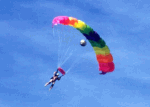 The landing came sooner rather than later (given the choice, I would have shortened the free fall so I could spend more time gliding through the sky). As we approached the ground, I braced my ankles tightly… then fell flat on my face instead of my rear.
The landing came sooner rather than later (given the choice, I would have shortened the free fall so I could spend more time gliding through the sky). As we approached the ground, I braced my ankles tightly… then fell flat on my face instead of my rear.
And then, there it was-the Bad Spot Cab Company pickup, with its appropriate placard-waiting to haul me back to the office. As promised, I fell, they hauled… and that’s all.
Standing on a ten-story tower gazing over Australia’s Great Barrier Reef, preparing to jump with one’s ankles tied together, offers even the most daring a new perspective on life. Was I scared… or, more to the point, how scared was I?
The continuous question, “Mary, have you ever bungee jumped?” was wearing thin. As a world traveler and adventurer, I have enjoyed scuba diving with sharks, hiking through developing (and less-developed) countries, flying single-engine turbo aircraft, and more. The bungee question was becoming irritating, in the very least.
Then I got my chance to end the questions. En route to Papua New Guinea, I visited Cairns, Australia, planning to spend a few days doing nothing more strenuous than recovering from jet lag. I didn’t realize that Cairns was known as a giant adult recreation camp, one of the best playgrounds in the world.
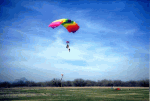 Each day was its own adventure. I forgot my jet lag and canoed the Mulgrave River, flew with the “postie” (mailman) 1,000 nautical miles over the Outback, fished for marlin on the Great Barrier Reef and in the nearby estuary. There was four-wheeling in the rain forest at Cape Tribulation, feeding kangaroos at the Cairns Zoo, the historic train ride to the aborigine town of Kuranda, and the bicycle ride back from Kuranda. I skipped scuba diving because I was on my way to Papua New Guinea, where I could dive the same reef system without the crowds.
Each day was its own adventure. I forgot my jet lag and canoed the Mulgrave River, flew with the “postie” (mailman) 1,000 nautical miles over the Outback, fished for marlin on the Great Barrier Reef and in the nearby estuary. There was four-wheeling in the rain forest at Cape Tribulation, feeding kangaroos at the Cairns Zoo, the historic train ride to the aborigine town of Kuranda, and the bicycle ride back from Kuranda. I skipped scuba diving because I was on my way to Papua New Guinea, where I could dive the same reef system without the crowds.
The questions about bungee jumping tantalized me. I decided to give them some thought on the twenty-mile bicycle ride down to A.J. Hackett’s in Smithfield, the founder of commercial bungee-jumping. I promised myself that it would be OK if I chickened out.
But somehow my bicycle brought me to A.J. Hackett’s, where I weighed in, thankfully in kilometers. The number was drawn on my hands so the bungee masters would know how to adjust the rope to my weight. The next challenge was forcing my legs to climb the 132 feet of steps to the top of the platform.
I stopped and could feel my knees wobbling below me. I was now determined to reach the top of the tower and jump-without taking time to consider the consequences.
The timing didn’t work out that way. At the top, an Australian television station was shooting a special on the bungee trend, which took about 15 minutes. My jump was furthered delayed when the woman in front of me freaked out on the platform and decided to walk down the stairs.
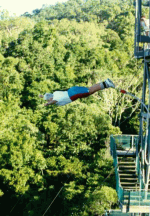 The wait had “iced” me. My legs were now like rubber bands. The bungee masters took no notice, wrapping my ankles in towels and binding them with cord.
The wait had “iced” me. My legs were now like rubber bands. The bungee masters took no notice, wrapping my ankles in towels and binding them with cord.
Shuffling out to the platform, I knew if I looked down at the pool of water below me, I would never have the courage to jump. Instead, I kept my gaze on the beauty of the Great Barrier Reef.
5-4-3-2-1, jump! I balked. The second countdown seemed endless and, with a breath and a prayer, I took a swan dive off the tower.
It took a second, but after the second and third recoil of the rope, I started cheering. Nothing hurt! I had defied death! Finally, I stopped bouncing and the bungee crew lowered me into the raft that would take me from the pool to the dock. My knees were shaking so much, they had to help me out of the raft.
Would I do it again? Well… once was enough. But now, when people ask, “Mary, have you bungee-jumped?” I can smile and say yes, of course.
Many people have asked me how I compare bungee jumping to skydiving. While both activities inspire fear followed by a huge adrenaline rush, I found bungee jumping is much more frightening. Additionally, skydiving appears to have more safety factors built into it. In the end, I can’t recommend that you try either activity, simply because I don’t encourage others to take risks. However, if you are so inclined, be sure that you pursue either path with an expert. Your life is, literally, in their hands. For further information, e-mail mary@peachin.com.
